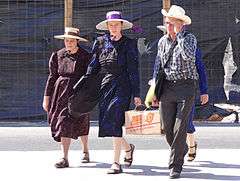Mennonites in Mexico
|
A Mennonite girl in Cuauhtémoc, Chihuahua | |
| Total population | |
|---|---|
| Approx. 100,000 (2012)[1] | |
| Regions with significant populations | |
| Chihuahua | 90,000[2] |
| Durango | 6,500[3] |
| Religions | |
| Anabaptist | |
| Scriptures | |
| The Bible | |
| Languages | |
| Plautdietsch, Spanish, Standard German, English[4] | |
There are 100,000 Mennonites (Spanish: Menonitas; German: Mennoniten) living in Mexico,[1] including 32,167 baptized adult church members;[5] about 90,000 are established in the state of Chihuahua[2] and 6,500 in Durango.[3] Other states with Mennonites colonies are Campeche, Tamaulipas, Zacatecas and Quintana Roo.
Their settlements were first established in the 1920s.[6] In 1922, 3,000 Mennonites from the Canadian province of Manitoba established in Chihuahua.[7] By 1927, Mennonites reached 10,000 and they were established in Chihuahua, Durango and Guanajuato.[7]
In 2012, about 1,500 Mennonites left Durango and moved to Canada due to severe droughts in Durango.[3]
History
Background
The ancestors of the vast majority of Mexican Mennonites settled in the Russian Empire in the late 18th and 19th centuries, coming from the Vistula delta in West Prussia. Even though these Mennonites are Dutch and German by ancestry, language and custom, they are generally called Russian Mennonites, Russland-Mennoniten in German. In the years after 1873 some 7,000 left the Russian Empire and settled in Canada. In the period leading up to and during World War I, governments in the Canadian provinces of Manitoba and Saskatchewan passed laws requiring public schools to fly the Union Jack, required compulsory attendance, and created public schools in areas of Mennonite settlement. In response the more conservative Mennonites sent out delegates to a number of countries to seek out a new land for settlement. They finally settled in a tract of land in Northern Mexico after negotiating certain privileges with Mexican President Álvaro Obregón. Approximately 6,000 of the most conservative Mennonites eventually left Manitoba and Saskatchewan for Mexico. The first train left Plum Coulee, Manitoba, on March 1, 1922.
Migration
Between 1922 and 1925 some 3,200 members of the Reinlaender Gemeinde in Manitoba and 1,200 from the Swift Current area left Canada to settle in Northern Mexico on approximately 230,000 acres (930 km2) of land in the Bustillos Valley near present-day Cuauhtémoc, Chihuahua. The Manitoba and Swift Current area groups settled the Manitoba and Swift Colonies in Chihuahua, while about 950 Mennonites from the Hague-Osler settlement in Saskatchewan settled on 35,000 acres (140 km2) in Durango near Nuevo Ideal.[8][9][10] In 1927 some 7,000 Mennonites from Canada lived in Mexico.[11]
Since 1924 Mennonites another 200 families, i.e. some 1000 persons from Russia, at that time called "Soviet Union" tried to settle in Mexico and in 1927 some 7,000 Mennonites from Canada and Russia lived in Mexico, but in the end only 6 out of 200 families from Russia remained in Mexico. Between 1948 and 1952 some 595 persons of the Kleine Gemeinde in Manitoba bought and settled the Quellenkolonie. They were joined by 246 Old Colony settlers from Manitoba and Saskatchewan, but most of these settlers either soon returned to Canada or left the colony.[12]
Settlements
The Mennonites established farms, machine shops and motorized vehicles for transporting produce (although automobiles were forbidden for common use). Canadian oats, beans and corn were the main produce. The villages followed Mennonite architectural styles existent in Russia and Canada and the names were based on former names in Canada such as Rosenort, Steinbach and Schönwiese. The colonies were based on former Mennonite social structures in terms of education, similar prayer houses and unsalaried ministers. Conservative dress and traditional roles for women were the norm.
Present
In Chihuahua, Mennonites continue their lifestyle with several reforms, such as the use of automobiles, although most use horse and buggy. They coexist, learning Spanish and English and living side by side with the Mestizo in the hill country of the state. During the harvest season they employ a considerable number of Tarahumara people from the nearby Copper Canyon area. About 50,000 Mennonites reside near the city of Cuauhtémoc in Chihuahua. In Durango, there are 32 Mennonite communities (30 in Nuevo Ideal Municipality and 2 in Santiago Papasquiaro Municipality). Mennonites in Durango number reached a top of 8,000 in 2011, now they are 6,500; most of them live in Nuevo Ideal. Nuevo Ideal's lies around 77 miles (124 km) north of the city of Durango. Once in Nuevo Ideal, it becomes central transit point where the main roads that communicate Northwest and Northeast Durango separate (the road going northwest to Santa Catarina de Tepehuanes is paved while the one going to Escobedo, Durango towards the northeast, is a dirt road). Mennonites benefit from this transit point since many travelers and truck drivers stop in Nuevo Ideal in search of Menonita Cheese.

The largest denomination as of 2006 is Old Colony Mennonite Church with 17,200 members. Evangelical Mennonite Mission Conference has 97 members, Kleingemeinde in Mexiko has 2,150 members, Reinländer-Gemeinde has 1,350 members, and Sommerfelder Mennonitengemeinde has 2,043 members.[13]
The community of Chihuahua separates themselves into "conservative" and "liberal", with the liberal faction accounting for 20% of the population.[14] This group is more open to outsiders and as such, more likely to marry outside of the community than their conservative peers.[14] It is also more common for this group to adopt Tarahumara and Mestizo children.[14] These children grow up as any other Mennonite would, learning German in school and helping out in the community.[14]
Since the start of the Mexican Drug War, many Mennonite colonies in Chihuahua have suffered the impact of the drug-related violence. The location of the colonies and the economic success of the Mennonites are the reasons why the community has been affected. The economic achievements have attracted the attention of organized criminal gangs, putting Mennonites at risk of armed robbery, kidnap and extortion. A small number of Mennonites have left the settlements and immigrated to other Mennonite settlements in Alberta, Canada, Belize and Paraguay to escape the violence. Thousands have moved and settled in more secure Mexican states like Campeche, or moved to South America, in countries like Argentina and Bolivia.[15]
There are accusations within the Mennonites that there are some Mennonites involved in the drug trade.[16][17] In 2014, Abraham Friesen-Remple was one of six members of the Northern Mexico's Mennonite community who were indicted and accused of smuggling pot in the gas tanks of cars and inside farm equipment. [18]
During 2007, the colony of Salamanca (a Mennonite settlement with a population of 800 spread over 4,900 acres (2,000 ha) in the state of Quintana Roo) was completely destroyed due to the landfall of Hurricane Dean.[19] As of 2008, Salamanca had a population of 862.[20]
A number of congregations of Conservative Mennonites have been established throughout Mexico including La Esperanza and Pedernales in Chihuahua (state), La Honda, Zacatecas, and more recently Oaxaca.
Film
The Mexican Mennonite community was the setting for the 2007 film Stellet Licht by acclaimed Mexican director Carlos Reygadas.
Literature
- Harry Leonard Sawatzky: They Sought a Country: Mennonite Colonization in Mexico, Berkeley, CA et al. 1971.
- Harry Leonard Sawatsky: Sie suchten eine Heimat : deutsch-mennonitische Kolonisierung in Mexiko, 1922 - 1984, Marburg 1986. (Not just a translation of the English book, but an own publication)
- Walter Schmiedehaus: Die Altkolonier-Mennoniten in Mexiko, Winnipeg 1982.
See also
References
- 1 2 Cascante, Manuel M. (8 August 2012). "Los menonitas dejan México". ABC (in Spanish). Retrieved 19 February 2013.
Los cien mil miembros de esta comunidad anabaptista, establecida en Chihuahua desde 1922, se plantean emigrar a la república rusa de Tartaristán, que se ofrece a acogerlos
- 1 2 Fierro, Luis (23 September 2012), Comunidad menonita planea migrar del país (in Spanish), El Universal, archived from the original on 27 September 2012, retrieved 20 September 2013,
(...) El gobierno de Chihuahua informó que desconoce los planes de los menonitas, cuya población se estima en alrededor de 90 mil personas en el estado, y sostuvo que las condiciones económicas actuales no son un factor que obligue a ningún productor local a abandonar la región. (...)
- 1 2 3 Ramírez, Laura (14 March 2012). "Se van mil 500 menonitas por sequía e inseguridad". El Siglo de Durango (in Spanish). Retrieved 5 March 2013.
Desalentados por la inseguridad y la falta de producción por la sequía de 2011, en los 12 meses recientes, cerca de mil 500 menonitas de una población total de ocho mil de las colonias de Nuevo Ideal y Santiago Papasquiaro emigraron a Canadá y otras entidades del país como Campeche y Chihuahua, donde se emplean en el campo o en talleres mecánicos. (...)
- ↑ William J. Frawley (2003). International Encyclopedia of Linguistics. 1. Oxford University Press. p. 94. ISBN 978-0-19-513977-8. Retrieved 23 May 2013.
- ↑ "Membership". Mennonite World Conference. 2014. Retrieved 27 October 2014.
- ↑ "The Mennonite Old Colony Vision: Under siege in Mexico and the Canadian Connection" (PDF). Archived from the original (PDF) on April 4, 2013. Retrieved February 17, 2015.
- 1 2 Hensen, Lawrence Douglas Taylor (Enero–Junio 2005). "Las migraciones menonitas al norte de México entre 1922 y 1940" (PDF). Migraciones Internacionales (in Spanish). 3 (1). Retrieved 5 March 2013. Check date values in:
|date=(help) - ↑ Ens, Adolf (1994). Subjects or Citizens?: The Mennonite Experience in Canada, 1870-1925. University of Ottawa Press. p. 208. ISBN 0-7766-0390-6.
- ↑ Krahn, Cornelius; Sawatzky, H. Leonard (1990). "Old Colony Mennonites". Global Anabaptist Mennonite Encyclopedia Online. Retrieved 23 May 2013.
- ↑ Krahn, Cornelius; Ens, Helen (1990). "Durango (Nuevo Ideál) Colony (Durango, Mexico)". Global Anabaptist Mennonite Encyclopedia Online. Retrieved 23 May 2013.
- ↑ "Mexico" at Global Anabaptist Mennonite Encyclopedia Online
- ↑ "Mexico" at Global Anabaptist Mennonite Encyclopedia Online
- ↑ Archived April 7, 2009, at the Wayback Machine.
- 1 2 3 4 Luis Fierro (2014). "Menonitas rompen tradición". El Universal. Retrieved 24 December 2014.
- ↑ http://www.nuevoidealdurango.com/?p=689
- ↑ "Drug war hits Mexico's Mennonites". BBC News. 2009-11-23. Retrieved 2010-05-12.
- ↑ "Mexican Mennonites | PRI's The World". Theworld.org. 2009-12-23. Retrieved 2012-09-20.
- ↑ "Mennonite Sentenced in Cartel Drug Smuggling Case". AOL. 2014-12-01. Retrieved 2015-08-19.
- ↑ Ovalle, David; Merzer, Martin (2007-08-23). "Dean makes for misery among Mennonites". The Seattle Times.
- ↑ "Menonitas, una comunidad atrapada en el Siglo XIX / Nacional". Elsiglodetorreon.com.mx. 2008-01-30. Retrieved 2012-09-20.
External links
- Mexican Farmers Exploring Tatarstan Agribusiness at The Kazan Herald
- Mexico at Global Anabaptist Mennonite Encyclopedia Online
- Protective Retreat: Mexico's Mennonites Consider a New Migration - The World and I

.svg.png)